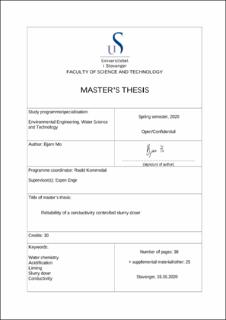| dc.contributor.advisor | Enge, Espen | |
| dc.contributor.author | Mo, Bjørn | |
| dc.coverage.spatial | Norway, Rogaland | en_US |
| dc.date.accessioned | 2021-04-19T08:37:29Z | |
| dc.date.available | 2021-04-19T08:37:29Z | |
| dc.date.issued | 2020-06-15 | |
| dc.identifier.uri | https://hdl.handle.net/11250/2738274 | |
| dc.description | Master's thesis in Environmental Engineering, Water Science and Technology | en_US |
| dc.description.abstract | Anthropogenic emissions of sulphur and nitrogen oxides cause acid rain giving acidic waters. Moreover, the bedrock in the southern parts of Norway provides no or little buffer capacity. This combination has caused fish species like Atlantic salmon and brown trout to extinction in many regions and locations. Liming of freshwaters is used as mitigation and has improved the conditions for aquatic organisms. Different liming strategies are used. Regularly liming of the catchment area and continues liming in rivers by a liming station is considered as the two most viable methods. These liming stations are usually controlled by water flow in combination with pH. Unfortunately, erroneous measures and doses will occur after a short time due to unavoidable drift of the pH electrode, even with a frequent calibration. A conductivity electrode, on the other hand, is highly stable and reliable. The liming station in Ørsdalen is the first of its kind because it is using conductivity as a control mechanism for lime dosing. This is possible due to a dynamical relationship between pH and sea salts expressed as conductivity.
The study establishes that the conductivity-controlled slurry doser can produce a stable pH regardless of the seasonal dynamic in water flow rate, pH upstream and the sea salt exposure. All episodes with pH values below critical value have been due to technical issues. The study suggests that the use of conductivity as a control parameter is more reliable than a pH-controlled liming station, as in Kvina. Ca measured downstream were found to be consistently higher than the doses curve implies, primarily due to the use of a preliminary dose table. | en_US |
| dc.language.iso | eng | en_US |
| dc.publisher | University of Stavanger, Norway | en_US |
| dc.relation.ispartofseries | Masteroppgave/UIS-TN-IKBM/2020; | |
| dc.rights | Navngivelse 4.0 Internasjonal | * |
| dc.rights.uri | http://creativecommons.org/licenses/by/4.0/deed.no | * |
| dc.subject | miljøteknologi | en_US |
| dc.subject | water chemistry | en_US |
| dc.subject | acidification | en_US |
| dc.subject | liming | en_US |
| dc.subject | slurry doser | en_US |
| dc.subject | environmental technology | en_US |
| dc.subject | conductivity | en_US |
| dc.title | Reliability of a conductivity controlled slurry doser | en_US |
| dc.type | Master thesis | en_US |
| dc.subject.nsi | VDP::Teknologi: 500::Miljøteknologi: 610 | en_US |

